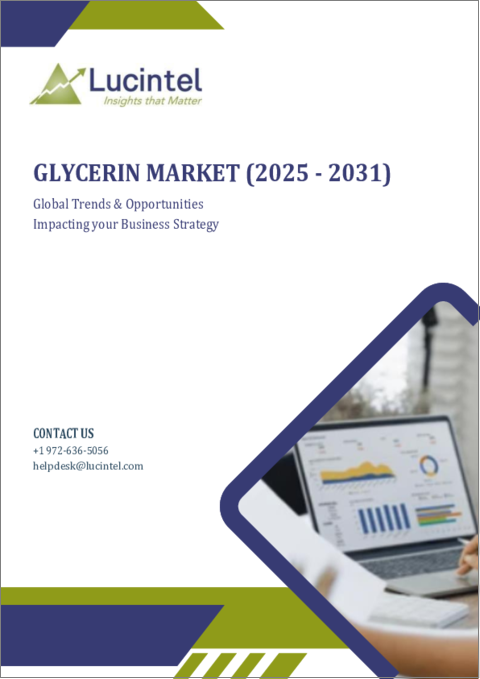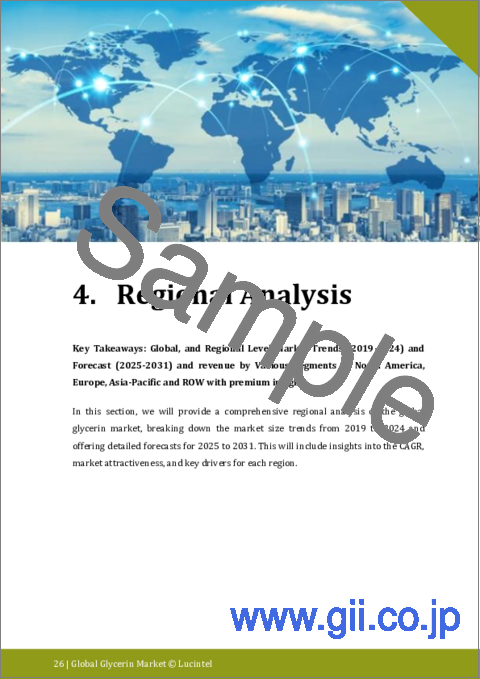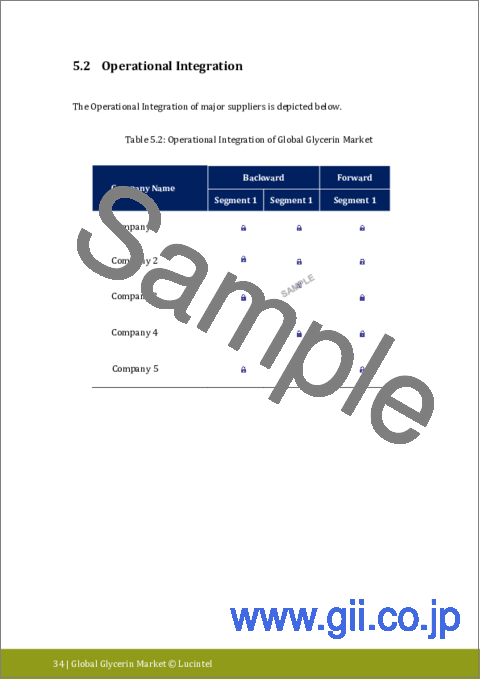|
|
市場調査レポート
商品コード
1661822
グリセリン市場レポート:動向、予測、競合分析 (2031年まで)Glycerin Market Report: Trends, Forecast and Competitive Analysis to 2031 |
||||||
カスタマイズ可能
適宜更新あり
|
|||||||
| グリセリン市場レポート:動向、予測、競合分析 (2031年まで) |
|
出版日: 2025年02月21日
発行: Lucintel
ページ情報: 英文 150 Pages
納期: 3営業日
|
全表示
- 概要
- 目次
世界のグリセリン市場の将来は、医薬品、食品・飲料、アルキド樹脂、パーソナルケア・化粧品、工業用化学品、ポリエーテルポリオール、タバコ保湿剤市場に機会があり、有望視されています。世界のグリセリン市場は、2025年から2031年までのCAGRが5.1%で、2031年までに推定28億米ドルに達すると予想されます。この市場の主な促進要因は、化粧品やパーソナルケア製品に対する需要の伸び、可処分所得の増加、新興国市場におけるこれらの製品に対する支出の増加です。さらに、グリセリンが自然で環境に優しい製品として消費者にアピールされつつあることも、市場拡大の原動力となっています。
- Lucintelの予測では、グレード別では粗グリセリンが予測期間中に高い成長を遂げる見込みです。
- 用途別では、パーソナルケア&化粧品が最も高い成長が見込まれます。
- 地域別では、消費者支出の増加、健康的なライフスタイルの受容の高まり、化粧品、パーソナルケア、栄養補助食品、医薬品などの最終用途分野の成長により、APACが予測期間中に最も高い成長を遂げると予想されます。
グリセリン市場の戦略的成長機会
グリセリンの主要用途市場は、いくつかの戦略的成長機会を提供します。市場参入企業は、この市場でのプレゼンスを高める機会を見出すことができます。
- 医薬品:医薬品製剤と溶剤としての用途はグリセリンの主要な用途の一部であり、成長機会が存在します。需要が増加するにつれて、メーカーは医薬品用に配合された高品質のグリセリンの生産に一層注力するようになると思われます。
- 化粧品とパーソナルケア:美容ケア製品における天然成分への需要の高まりは、グリセリン・メーカーにチャンスをもたらします。保湿剤としてのグリセリンを重視した処方革新も市場シェア拡大に貢献します。
- 食品・飲料業界:グリセリンは食品添加物および保湿剤として使用されるため、この業界では有利な立場にあります。クリーンラベル製品や自然食品への需要の高まりに成長機会が見出されます。
- バイオ燃料および再生可能エネルギー産業:バイオディーゼルの製品別として、この燃料の生産からグリセリンが得られます。企業はバイオディーゼル・メーカーと提携することで、この新興市場での露出を高め、グリセリンの供給を増やすことができます。
- eコマースの成長:eコマースの開発により、メーカーはさまざまな消費者層への流通チャネルを拡大できるようになります。eコマースの販売チャネルや広告ツールの開発により、知名度が向上し、売上が増加する可能性があります。
こうした機会は、グリセリン業界におけるイノベーションと市場シェア拡大の可能性を示唆しています。
グリセリン市場の促進要因・課題
技術経済および規制要因は、グリセリン市場に様々な面で影響を与えます。これらの要因は、業界の利害関係者に貴重な洞察を提供します。
グリセリン市場を牽引する要因は以下の通りです:
- 多方面での使用の増加:医薬品、化粧品、食品の各分野でグリセリンの消費量が増加しており、これが市場成長の原動力となっています。グリセリンはこれらの産業分野で不可欠な製品です。
- 持続可能性への取り組み:バイオベースで持続可能な製品の採用が増加しているため、グリセリンはさらに魅力的な選択肢となっています。消費者や企業は環境に優しい代替品に注目しており、これが需要の増加につながっています。
- 技術の進歩:グリセリンの製造・配合技術は、製品の品質と効率の面で改善されつつあります。こうした進歩は、グリセリンの利用機会を増やし、競争力を高めます。
- 規制支援:バイオベースおよび天然製品を促進する支持的な規制は、メーカーが持続可能性と品質基準を遵守することで、市場の成長に貢献します。
- 健康とウェルネスの動向:健康とウェルネスに対する意識の高まりは、特にパーソナルケア製品や食品において、グリセリンのような天然で安全な原料への需要を促進しています。
グリセリン市場の課題は以下の通りです:
- 価格の変動:原料価格の変動により、グリセリンメーカーは収益性を維持するために生産工程の調整を余儀なくされる可能性があります。このような状況では、効果的なコスト管理戦略が必要となります。
- 激しい競合:グリセリン市場は競争が激しく、市場シェアを維持するために価格引き下げや技術革新の圧力が常にかかります。
- 規制遵守コスト:厳しい規制要件はメーカーに多大なコストを課し、成長とイノベーションへの投資能力を制限します。
需要の増加や持続可能性への取り組みといった促進要因は成長機会をもたらしますが、価格変動や規制遵守といった課題は、グリセリン市場での持続的な成功を確保するための戦略的計画を必要とします。
目次
第1章 エグゼクティブサマリー
第2章 世界のグリセリン市場:市場力学
- イントロダクション、背景、分類
- サプライチェーン
- 業界の促進要因と課題
第3章 市場動向と予測分析 (2019年~2031年)
- マクロ経済動向 (2019~2024年) と予測 (2025~2031年)
- 世界のグリセリン市場の動向 (2019~2024年) と予測 (2025~2031年)
- 世界のグリセリン市場:グレード別
- 粗製グリセリン
- 精製グリセリン
- 世界のグリセリン市場:原料別
- バイオディーゼル
- 脂肪酸
- 脂肪アルコール
- その他
- 世界のグリセリン市場:用途別
- 製薬
- 食品・飲料
- アルキド樹脂
- パーソナルケア・化粧品
- 工業用化学品
- ポリエーテルポリオール
- タバコ保湿剤
- その他
第4章 地域別の市場動向と予測分析 (2019年~2031年)
- 世界のグリセリン市場:地域別
- 北米のグリセリン市場
- 欧州のグリセリン市場
- アジア太平洋のグリセリン市場
- その他地域のグリセリン市場
第5章 競合分析
- 製品ポートフォリオ分析
- 運用統合
- ポーターのファイブフォース分析
第6章 成長機会と戦略分析
- 成長機会分析
- 世界のグリセリン市場の成長機会:グレード別
- 世界のグリセリン市場の成長機会:原料別
- 世界のグリセリン市場の成長機会:用途別
- 世界のグリセリン市場の成長機会:地域別
- 世界のグリセリン市場の新たな動向
- 戦略的分析
- 新製品の開発
- 世界のグリセリン市場の生産能力拡大
- 世界のグリセリン市場における企業合併・買収 (M&A)、合弁事業
- 認証とライセンシング
第7章 主要企業のプロファイル
- Aemetis
- BASF SE
- Biodex-SA
- Cargill Incorporated
- Dow
- Emery Oleochemicals
- Godrej Industries
The future of the global glycerin market looks promising with opportunities in the pharmaceutical, food & beverage, alkyd resin, personal care & cosmetics, industrial chemical, polyether polyols, and tobacco humectant markets. The global glycerin market is expected to reach an estimated $2.8 billion by 2031 with a CAGR of 5.1% from 2025 to 2031. The major drivers for this market are the growth in demand for cosmetics and personal care products, an increase in disposable income, and higher spending on these items in developing nations. Additionally, glycerin's growing appeal to consumers as a natural and environmentally friendly product is driving market expansion.
- Lucintel forecasts that, within the grade category, crude glycerin is expected to witness higher growth over the forecast period.
- Within the application category, personal care & cosmetics is expected to witness the highest growth.
- In terms of regions, APAC is expected to witness the highest growth over the forecast period due to increased consumer spending, a rising acceptance of healthy lifestyles, and the growth of end-use sectors like cosmetics, personal care, nutraceuticals, and pharmaceuticals in the region.
Gain valuable insights for your business decisions with our comprehensive 150+ page report.
Emerging Trends in the Glycerin Market
The transformation that is going to be witnessed in the glycerin market is multifaceted and anchored by diverse trends, which impact consumer preferences as well as the nature of the regulatory environment. These trends will be critical in guiding the direction of manufacturers and stakeholders.
- Sustainability and Bio-Based Products: Renewable glycerin is being sought by consumers for its sustainable nature. Hence, manufacturers are adopting greener practices and finding new sources for improvement in the marketplace.
- Clean Label Movement: Consumers are increasingly seeking the origin of ingredients and the formulation processes. Glycerin, being a natural product, has become much more favored with the rise of health-conscious demands, especially in the food and cosmetics industries.
- Innovative Formulations: Glycerin-based products are being developed with advanced formulation technologies to meet the ever-growing demand for high-performance products. Innovative formulations are expanding the scope of glycerin applications in the food, pharmaceutical, and personal care industries.
- Regulatory Support: Governments are framing and implementing regulations that support bio-based products. This compliance is encouraging companies to invest in sustainable practices and product development.
- Increased E-Commerce: The rise of e-commerce enables the widespread distribution of glycerin-based products in personal care and wellness. Online platforms help manufacturers expand their consumer markets, thereby promoting higher sales growth.
New trends in the glycerin market-such as sustainability, innovative formulations, and rising demand across various sectors-are changing the industry, driving growth, and encouraging manufacturers to be more eco-friendly and explore new applications.
Recent Developments in the Glycerin Market
The glycerin market is one of those markets that is showing a number of important developments that will determine its future. The evolution reveals the industry's response to changing demands and market conditions.
- Improvement in Technological Processes: Glycerin manufacturers are improving yield and quality by investing in new extraction and purification technologies. These innovations increase efficiency, lower costs, and enhance the competitiveness of glycerin in diverse applications.
- Growth of Bio-Based Glycerin: Bio-based glycerin is gaining significant ground in the market. Much progress has been made over the past few years, driven by regulatory support for sustainable practices and growing consumer demand for eco-friendly products.
- Personal Care Applications: The personal care industry is increasingly adopting glycerin in formulations, mainly due to its moisturizing and skin-benefiting effects. This expands the market for glycerin, especially in cosmetics and skincare products.
- Focus on Quality and Safety Standards: With strict regulatory frameworks, manufacturers are striving to meet safety and quality standards. This will enhance consumer confidence and, in turn, increase demand for high-purity glycerin products.
- Growth in E-Commerce Platforms: Glycerin-based products are expanding their reach through e-commerce platforms. The e-commerce sector is advancing rapidly, with all channels needed to connect with customers, as the personal care and health sectors have become dominant consumers.
These developments reflect the dynamic nature of the glycerin market and the industry's commitment to innovation and sustainability.
Strategic Growth Opportunities for Glycerin Market
The key applications market for glycerin provides several strategic growth opportunities. Market participants can identify opportunities to advance their presence in this market.
- Pharmaceutical: Drug formulation and as a solvent are some of the key applications of glycerin, where growth opportunities exist. As demand increases, manufacturers will focus more on producing high-quality glycerin formulated for use in pharmaceuticals.
- Cosmetics and Personal Care: The rising demand for natural ingredients in beauty care products opens up opportunities for glycerin manufacturers. Formulation innovation that emphasizes glycerin as a moisturizer will also help increase market share.
- Food and Beverage Industry: Glycerin's use as a food additive and humectant positions it favorably in this industry. Opportunities for growth are found in the increasing demand for clean-label products and natural foods.
- Biofuels and Renewable Energy Industry: As a by-product of biodiesel, glycerin can be derived from the production of this fuel. Companies can partner with biodiesel manufacturers for greater exposure in this emerging market and to increase glycerin supply.
- E-commerce Growth: The development of e-commerce will enable manufacturers to extend their distribution channels to various consumer groups. Developing more e-commerce sales channels and advertising tools may enhance visibility and increase sales.
These opportunities suggest the potential for innovation and expansion of market share in the glycerin industry.
Glycerin Market Driver and Challenges
Techno-economic and regulatory factors influence the glycerin market in many aspects. These factors provide stakeholders in the industry with valuable insights.
The factors responsible for driving the glycerin market include:
- Increased Usage in Multiple Sectors: The pharmaceutical, cosmetics, and food sectors are consuming higher quantities of glycerin, which is driving market growth. Glycerin is an essential product in these industry sectors.
- Sustainability Initiatives: The increasing adoption of bio-based and sustainable products is making glycerin an even more attractive option. Consumers and companies are focusing on eco-friendly alternatives, which has led to increased demand.
- Technological Advancements: Manufacturing and formulation technologies for glycerin are being improved in terms of product quality and efficiency. These advancements will create more opportunities for using glycerin and increase its competitiveness.
- Regulatory Support: Supportive regulations promoting bio-based and natural products will help grow the market as manufacturers adhere to sustainability and quality standards.
- Health and Wellness Trends: Increased health and wellness awareness is driving demand for natural and safe ingredients, such as glycerin, especially in personal care and food products.
Challenges in the glycerin market include:
- Price Volatility: Fluctuations in raw material prices may force glycerin manufacturers to adjust production processes to maintain profitability. Such circumstances require effective cost-management strategies.
- Intense Competition: The glycerin market is highly competitive, with constant pressure for price reductions and innovation to maintain market share.
- Regulatory Compliance Costs: Strict regulatory requirements impose significant costs on manufacturers, limiting their ability to invest in growth and innovation.
Although drivers such as increasing demand and sustainability initiatives offer growth opportunities, challenges like price volatility and regulatory compliance require strategic planning to ensure sustained success in the glycerin market.
List of Glycerin Companies
Companies in the market compete on the basis of product quality offered. Major players in this market focus on expanding their manufacturing facilities, R&D investments, infrastructural development, and leverage integration opportunities across the value chain. Through these strategies glycerin companies cater increasing demand, ensure competitive effectiveness, develop innovative products & technologies, reduce production costs, and expand their customer base. Some of the glycerin companies profiled in this report include-
- Aemetis
- BASF SE
- Biodex-SA
- Cargill Incorporated
- Dow
- Emery Oleochemicals
- Godrej Industries
Glycerin by Segment
The study includes a forecast for the global glycerin market by grade, source, application, and region.
Glycerin Market by Grade [Analysis by Value from 2019 to 2031]:
- Crude Glycerin
- Refined Glycerin
Glycerin Market by Source [Analysis by Value from 2019 to 2031]:
- Biodiesels
- Fatty Acids
- Fatty Alcohols
- Others
Glycerin Market by Application [Analysis by Value from 2019 to 2031]:
- Pharmaceutical
- Food & Beverage
- Alkyd Resin
- Personal Care & Cosmetic
- Industrial Chemicals
- Polyether Polyols
- Tobacco Humectants
- Others
Glycerin Market by Region [Analysis by Value from 2019 to 2031]:
- North America
- Europe
- Asia Pacific
- The Rest of the World
Country Wise Outlook for the Glycerin Market
Today, the glycerin market is experiencing significant growth as it is in demand across various sectors such as food, pharmaceuticals, and personal care. Glycerin is gaining traction due to its moisturizing properties and health benefits, particularly in sustainable and natural ingredient-based formulations. Other regions-such as the United States, China, Germany, India, and Japan-are changing production technologies, regulatory shifts, and evolving consumer demand. This is contributing to growth and innovation, with new application developments and sustainability initiatives aimed at meeting current market demands.
- United States: The glycerin market in the United States is growing in response to the increasing demand for natural and organic products in the food and personal care sectors. Aligning with sustainability trends, there is a focus on high-purity glycerin derived from renewable sources. Additionally, advances in extraction technologies are making glycerin production more efficient. Supportive regulations for bio-based products are driving the development of this market. In the cosmetics market, glycerin is increasingly adopted for its moisturizing and humectant properties, which is driving innovation in formulations and expanding its range of applications.
- China: The glycerin market in China is growing rapidly, fueled by the expanding pharmaceutical and cosmetics industries. Increased production capacity and strong production techniques have made glycerin more affordable. The government's emphasis on environmentally friendly production has motivated manufacturers to adopt greener production methods. Increased access to glycerin-based products through e-commerce has also made them more accessible to consumers. Personal care is one of the leading sectors for glycerin-based products, and demand continues to rise as consumers shift toward natural ingredients, ensuring continued demand for glycerin in formulations.
- Germany: The glycerin market in Germany is gaining momentum due to stringent regulatory guidelines and a growing focus on sustainability. Germany is considered a leading producer of bio-based glycerin, with manufacturers investing in innovative processes to improve purity and reduce environmental impact. The food and pharmaceutical industries are the primary drivers of glycerin demand, as companies seek natural alternatives for their formulations. Additionally, the clean-label product trend is benefiting the adoption of glycerin in food applications, further solidifying its market presence.
- India: The glycerin market in India is expected to surge shortly due to increased demand in pharmaceutical and cosmetic applications. The government's growing support for biofuel manufacturing is also driving the production of glycerin as a by-product in biodiesel production. Efforts are being made to improve the productivity and quality of domestic manufacturers so they can meet both domestic and export market demands. With a growing population and rising disposable income, the demand for glycerin-based products, especially in personal care and healthcare, is on the rise, further augmenting the market's potential.
- Japan: The glycerin market in Japan is expected to be dominated by high-quality and safe glycerin for the food and cosmetic industries, with increasing applications related to the aging population. Manufacturers are differentiating themselves through innovation and quality, as safety regulations are very strict. Natural and organic products have gained popularity recently, leading to more formulations containing glycerin as an ingredient. Moreover, the trend toward more sustainable sourcing is rising in the Japanese market, making glycerin derived from renewable resources even more appealing.
Features of the Global Glycerin Market
Market Size Estimates: Glycerin market size estimation in terms of value ($B).
Trend and Forecast Analysis: Market trends (2019 to 2024) and forecast (2025 to 2031) by various segments and regions.
Segmentation Analysis: Glycerin market size by grade, source, application, and region in terms of value ($B).
Regional Analysis: Glycerin market breakdown by North America, Europe, Asia Pacific, and Rest of the World.
Growth Opportunities: Analysis of growth opportunities in different grade, source, application, and regions for the glycerin market.
Strategic Analysis: This includes M&A, new product development, and competitive landscape of the glycerin market.
Analysis of competitive intensity of the industry based on Porter's Five Forces model.
If you are looking to expand your business in this or adjacent markets, then contact us. We have done hundreds of strategic consulting projects in market entry, opportunity screening, due diligence, supply chain analysis, M & A, and more.
This report answers following 11 key questions:
- Q.1. What are some of the most promising, high-growth opportunities for the glycerin market by grade (crude glycerin and refined glycerin), source (biodiesels, fatty acids, fatty alcohols, and others), application (pharmaceutical, food & beverage, alkyd resin, personal care & cosmetic, industrial chemicals, polyether polyols, tobacco humectants, and others), and region (North America, Europe, Asia Pacific, and the Rest of the World)?
- Q.2. Which segments will grow at a faster pace and why?
- Q.3. Which region will grow at a faster pace and why?
- Q.4. What are the key factors affecting market dynamics? What are the key challenges and business risks in this market?
- Q.5. What are the business risks and competitive threats in this market?
- Q.6. What are the emerging trends in this market and the reasons behind them?
- Q.7. What are some of the changing demands of customers in the market?
- Q.8. What are the new developments in the market? Which companies are leading these developments?
- Q.9. Who are the major players in this market? What strategic initiatives are key players pursuing for business growth?
- Q.10. What are some of the competing products in this market and how big of a threat do they pose for loss of market share by material or product substitution?
- Q.11. What M&A activity has occurred in the last 5 years and what has its impact been on the industry?
Table of Contents
1. Executive Summary
2. Global Glycerin Market : Market Dynamics
- 2.1: Introduction, Background, and Classifications
- 2.2: Supply Chain
- 2.3: Industry Drivers and Challenges
3. Market Trends and Forecast Analysis from 2019 to 2031
- 3.1. Macroeconomic Trends (2019-2024) and Forecast (2025-2031)
- 3.2. Global Glycerin Market Trends (2019-2024) and Forecast (2025-2031)
- 3.3: Global Glycerin Market by Grade
- 3.3.1: Crude Glycerin
- 3.3.2: Refined Glycerin
- 3.4: Global Glycerin Market by Source
- 3.4.1: Biodiesels
- 3.4.2: Fatty Acids
- 3.4.3: Fatty Alcohols
- 3.4.4: Others
- 3.5: Global Glycerin Market by Application
- 3.5.1: Pharmaceutical
- 3.5.2: Food & Beverage
- 3.5.3: Alkyd Resin
- 3.5.4: Personal Care & Cosmetic
- 3.5.5: Industrial Chemicals
- 3.5.6: Polyether Polyols
- 3.5.7: Tobacco Humectants
- 3.5.8: Others
4. Market Trends and Forecast Analysis by Region from 2019 to 2031
- 4.1: Global Glycerin Market by Region
- 4.2: North American Glycerin Market
- 4.2.1: North American Market by Grade: Crude and Refined Glycerin
- 4.2.2: North American Market by Application: Pharmaceutical, Food & Beverage, Alkyd Resin, Personal Care & Cosmetic, Industrial Chemicals, Polyether Polyols, Tobacco Humectants, and Others
- 4.3: European Glycerin Market
- 4.3.1: European Market by Grade: Crude and Refined Glycerin
- 4.3.2: European Market by Application: Pharmaceutical, Food & Beverage, Alkyd Resin, Personal Care & Cosmetic, Industrial Chemicals, Polyether Polyols, Tobacco Humectants, and Others
- 4.4: APAC Glycerin Market
- 4.4.1: APAC Market by Grade: Crude and Refined Glycerin
- 4.4.2: APAC Market by Application: Pharmaceutical, Food & Beverage, Alkyd Resin, Personal Care & Cosmetic, Industrial Chemicals, Polyether Polyols, Tobacco Humectants, and Others
- 4.5: ROW Glycerin Market
- 4.5.1: ROW Market by Grade: Crude and Refined Glycerin
- 4.5.2: ROW Market by Application: Pharmaceutical, Food & Beverage, Alkyd Resin, Personal Care & Cosmetic, Industrial Chemicals, Polyether Polyols, Tobacco Humectants, and Others
5. Competitor Analysis
- 5.1: Product Portfolio Analysis
- 5.2: Operational Integration
- 5.3: Porter's Five Forces Analysis
6. Growth Opportunities and Strategic Analysis
- 6.1: Growth Opportunity Analysis
- 6.1.1: Growth Opportunities for the Global Glycerin Market by Grade
- 6.1.2: Growth Opportunities for the Global Glycerin Market by Source
- 6.1.3: Growth Opportunities for the Global Glycerin Market by Application
- 6.1.4: Growth Opportunities for the Global Glycerin Market by Region
- 6.2: Emerging Trends in the Global Glycerin Market
- 6.3: Strategic Analysis
- 6.3.1: New Product Development
- 6.3.2: Capacity Expansion of the Global Glycerin Market
- 6.3.3: Mergers, Acquisitions, and Joint Ventures in the Global Glycerin Market
- 6.3.4: Certification and Licensing
7. Company Profiles of Leading Players
- 7.1: Aemetis
- 7.2: BASF SE
- 7.3: Biodex-SA
- 7.4: Cargill Incorporated
- 7.5: Dow
- 7.6: Emery Oleochemicals
- 7.7: Godrej Industries





